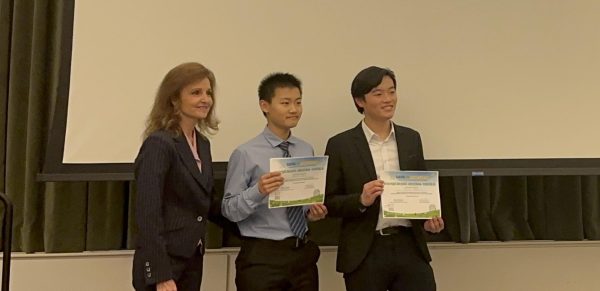New Elmbrook initiative: going paperless
District initiative encourages saving trees and money by reducing paper usage
If you’ve gone to print at the library in the past few weeks, you might have noticed a poster behind the printer with a crying Paul Bunyan on it urging you to save paper. The disappointed lumberjack is the new face of the Elmbrook School District’s initiative to reduce paper consumption within schools. This new initiative states that for each school within the district that reduces their copier usage by 5 percent (from the previous year), a new tree will be planted on that school’s campus. The initiative also states that, for a greater amount of paper reduction, a greater amount of trees will be planted. Director of Technology Dan Scott and User Technology Specialist Jean Lopfe are the two district officials spearheading the whole initiative, the two are attempting to make teachers and students alike more aware of their paper consumption.
Although much of the initiative was created in an attempt to save money, Scott clarified that the environmental footprint of the district was just as important: “I think each year we would reflect on the costs that we are incurring to print and produce output for students and I felt each year that that cost has incrementally increased. We thought there was a big opportunity to have fun with incentivising reducing printing through the promise of a tree.” For all printing output, not including the costs of the copiers themselves, Scott estimated that the district spends about $125,000 a year, but if schools were to reduce their paper consumption by 5 percent it would save about $5,000.
So, with this initiative in mind, what can students personally do to lower their own usage? Primarily, students can continue to conduct much of their work online such as taking notes, organizing files, and storing important documents. Reading papers, conducting research, and taking notes online greatly reduces paper usage and allows for all of your documents to be stored safely in one place without risk of losing them as easily as you can lose a notebook. Additionally, students can be more aware of what they are printing. Instead of printing a 20-page essay single-sided, check with you teacher and see if it would be okay if it was double-sided instead. Lopfe said encouraging students and teachers to use their resources was another goal of the initiative, “We’re really trying to promote more sharing through Google, we are in a Google environment so rather than printing, sharing and collaborating more digitally is one of our goals.”
The task of “sharing and collaborating more digitally,” however, has found some pushback from students and teachers.
Mrs. Ordinans, a math teacher infamous for the amount of paper she hands out to students, said she only did so because she felt that writing new concepts out on paper contributed to the learning experience.
“I know we’re supposed to try to reduce the amount of paper and I do try, but I just find that students really do like to have paper copies in front of them,” Mrs. Ordinans said. “Part of learning is writing it out. I feel you can go too far with the electronic stuff with the kids.”
Math might just be one of those subjects that works better on paper, though. Unlike Mrs. Ordinans, English teacher Mr. Perez has nearly all of his assignments done electronically.
“I don’t want to waste paper, but I’ll be honest, the paper initiative doesn’t really decide the way I do the things that I do,” Mr. Perez said. “The reason why I do stuff online is because then I don’t have to worry about losing stuff and I don’t have to worry about making copies. But sometimes I want to make copies, especially for reading stuff like short stories and poems that you want to annotate and make notes on.
“To be honest,” he continued, “I don’t think teachers are necessarily thinking about paper when they’re planning their lessons and what they’re going to do. They think about what works best in their classroom.”
“I feel as though I’m not saving a whole lot of paper but it’s because I still want those copies in front of my kids,” Mrs. Ordinans said. “And that’s the feedback I get from my students, they want the paper too.”
There are countless studies that say handwriting notes is beneficial for the brain (just Google “handwriting helping learning” and thou shalt be rewarded), but one student in particular has found a way to get the best of both worlds.
“I started using my iPad second semester of junior year,” said Kyle Lee (‘20). “Before that I was just using notebooks and stuff like everyone else. Once my dad got his new iPad I got his old one, I decided that oh, it would be kind of cool to start taking notes on that iPad just to see what it’s like.”
After doing extensive research, Lee paid $10 for an app called GoodNotes (currently $7.99 on the App Store). He uses a stylus to write directly on the electronic documents, turning the iPad into a notebook of infinite pages.
“It gives you a full access to edit notebooks and stuff and you can make your own notebooks in the app,” Lee explained. “You can also edit PDFs which is really useful because when I was in Mrs. Ordinans’ stats class she gave out a lot of paper. I downloaded a scanner app and I scanned in all of her papers and put it into my iPad so I could do all the work on there. That way I had a lot more room to play around with. I also had all my documents and stuff on my iPad instead of a million sheets of paper in my folder, so it kept me a little more organized.”
Despite his success with it, Lee acknowledged that not everyone has an iPad lying around, especially when the district hands out Chromebooks to every student.
“I know everyone uses their Chromebook,” he said, “but the problem with Chromebooks is that typing notes is not the same as handwriting notes. And that’s something I really looked into when I was using my iPad because I wanted the same element of handwriting notes instead of just typing them, which is one way that really helps me retain information. So I think the easiest way is if you have a touchscreen device.”
The ultimate goal of the paper initiative, regardless of how it is achieved, remains the same: to save paper and therefore save money. Whether the bulk of that responsibility lies on the teachers or students remains to be seen.
“I think it will be effective in the long run,” said science teacher Mr. Gryzwa. “Everybody has a computer now so theoretically it should work, the problem is a lot of departments don’t have textbooks or even online books, so it makes it difficult, it almost forces them to make copies.”
As advisor of the Environmental Club, Mr. Gryzwa emphasized that the success of the paper initiative depended on not only saving but recycling paper.
“Paper is the component that ends up in recycling landfills the most,” he said. “One of the things that the Environmental Club talked about doing was these posters above the recycling bins so that teachers and students know what the right stuff is to throw in there. When the Environmental Club was brainstorming ideas, I kind of pushed that one a bit because it’s a good initiative.”
“I’m not sure how far the district is going to go with the paper initiative,” said Mr. Perez. “Is it good to save money? Yes. Is it good to save money at the expense of doing stuff in my classroom that I think is good for my students? No. So, I guess teachers will cooperate and in the end we’ll do what we’re told by the school district, nut in the end we’re going to do what we think is best for our students.”
Neha Ajjampore is currently a senior and the Visual Director or Tyro. She plays the flute in and out of school, also in the marching band and the Wind...










